Designing a Functional Kitchen for Studio Apartments
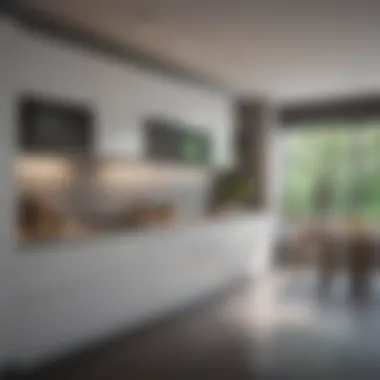
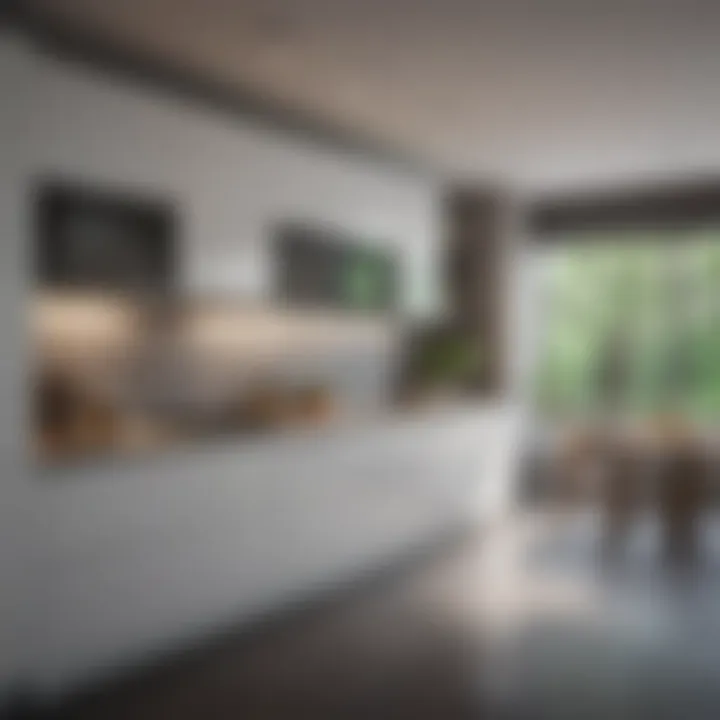
Intro
Designing a kitchen in a studio apartment presents unique challenges. The compact space requires strategic planning to ensure the area is not just functional, but also aesthetically pleasing. This article explores various design elements that can help elevate the cooking space while maximizing efficiency. From layout options to storage solutions, every detail counts in crafting a delightful kitchen experience.
Design Inspiration
Trending Styles
When it comes to studio kitchens, minimalism is often a preferred approach. The trend leans towards clean lines and uncluttered spaces. Open shelving remains popular as it provides both accessibility and a visual lightness to the area. In addition, the modern approach often incorporates mixed materials, like metal and wood, to bring depth to simple designs. This style emphasizes simplicity and functionality.
Another trending style is the use of industrial design elements. Exposed pipes and brick walls can create an urban aesthetic, contributing to a modern and stylish kitchen. The combination of dark colors with bright accents can enhance the kitchen without overwhelming the space. This style proves equally practical as it often emphasizes durable materials, essential in a high-use area.
Color Palettes
Choosing the right color palette is crucial in a studio kitchen. Light colors, such as whites and soft pastels, can make the space feel larger and more open. These tones reflect natural light and prevent the kitchen from feeling cramped. Conversely, darker hues can add an intimate feel, but using them in moderation is important.
Consider using a two-tone approach where cabinets can be a light color while countertops are a darker shade. This can create a striking contrast while maintaining balance. Incorporating bold colors in smaller accents, like utensils or decor pieces, can also add personality without consuming significant space.
Important Tip: Always test paint samples in your studio before committing. Light changes throughout the day can alter the perceived color and mood of the kitchen.
Practical Tips
Maintenance & Care
In a small kitchen, every surface and appliance must be easily maintainable. Choosing materials that resist stains and are easy to clean is essential. For counter surfaces, quartz or granite is highly recommended due to their durability. Similarly, selecting non-porous materials for cabinets can prevent moisture accumulation and potential damage.
Regular cleaning is essential in maintaining the freshness of the space. Schedule routine deep cleaning every few weeks to keep everything in order. This not only promotes hygiene but also prolongs the life of your appliances and fixtures.
Budgeting & Planning
Financial planning is fundamental when designing a studio kitchen. Start by assessing your budget and breaking it down into essential categories: appliances, materials, and decor. It is wise to prioritize quality in major purchases like refrigerators and ovens. These foundational elements can impact functionality and long-term satisfaction significantly.
For cabinetry, consider ready-to-assemble options if a custom design is beyond your budget. This can significantly reduce costs while still giving you a polished finish.
Understanding Studio Apartment Kitchens
Understanding studio apartment kitchens is crucial when designing a space that serves both functionality and style. The kitchen plays a vital role in the overall living experience of studio residents. It often serves as a focal point where cooking, dining, and socializing occur. Given the compact nature of studio apartments, utilizing the kitchen area effectively can enhance the overall use of space.
Defining the Studio Apartment Concept
Studio apartments come in various configurations but generally share a common characteristic: they have an open floor plan that combines multiple living spaces into one. This design can include a sleeping area, living room, and kitchen share, often without traditional walls separating these areas.
The studio concept caters to urban dwellers looking for affordable and efficient living arrangements. With rising housing prices in many cities, this setup allows for a cozy yet practical lifestyle. Studio apartments emphasize maximizing usable space while providing essential amenities.
The living area typically also acts as a social space, meaning the kitchen must both be functional for cooking and inviting for entertaining guests. Therefore, understanding the studio concept is necessary for creating a harmonious kitchen environment that suits the dynamics of small living spaces.
The Role of the Kitchen in Small Spaces
In small spaces like studio apartments, the kitchen represents more than just a place to prepare meals. It plays a multifaceted role, contributing to daily routines and social interactions. Here are some key aspects to consider:
- Meal Preparation: The kitchen must support diverse cooking methods, despite its limited size. Smart design choices can facilitate efficient meal prep without crowding.
- Eating Area: Often, the kitchen doubles as a dining space. This dual function requires careful consideration of layout and seating options.
- Social Interaction: Open-plan designs mean the kitchen is visible from the living area. Therefore, aesthetics hold significant value alongside functionality. A kitchen that is cluttered or poorly designed can disrupt the flow of the entire space.
- Storage: Limited square footage necessitates creative storage solutions. Every inch counts, and maximizing vertical space can lead to more organized, efficient kitchens.
Key Considerations for Kitchen Design
Designing a kitchen for a studio apartment involves a careful balance of functionality and style. The key considerations for kitchen design encompass various elements that enhance the cooking experience while optimizing the limited space available. The small area can lead to a range of challenges, but understanding and addressing these considerations helps in creating an environment that is both practical and aesthetically pleasing.
Assessing Your Cooking Habits
An essential step in designing a functional kitchen is assessing your cooking habits. This means reflecting on how often you cook, the types of meals you prepare, and the appliances you rely on. If you often prepare elaborate meals, for instance, you may need more counter space and a larger stove. Alternatively, if your cooking is more limited, you might prioritize the storage of simple cookware and utensils.
Understanding your preferences helps in making informed choices about appliances and storage solutions. For example, a home chef may benefit from having additional shelving for spices or a larger cutting board, while someone who cooks less frequently might prefer compact appliances that can be easily stored away when not in use.
"Assessing cooking habits early in the design process can save time and resources."
Incorporating multipurpose tools also enhances efficiency. A blender that can chop, blend, and process food reduces the need for multiple gadgets. This consolidation of tools is particularly crucial in a studio kitchen where space is a premium.
Evaluating Available Space
The evaluation of available space plays a crucial role in kitchen design, especially in a studio apartment environment. Start by measuring the dimensions of the kitchen area, taking into account any structural elements like walls, windows, and doors. This evaluation allows you to visualize where each piece of furniture or appliances will fit, which is vital for maintaining functionality.
Consider both the total area and the layout possibilities. Different designs, like the galley or L-shaped layouts, can optimize movement and accessibility. Each layout has its benefits; for example, a galley kitchen is efficient for cooking but might feel confined. In contrast, an L-shaped kitchen can provide more open space without sacrificing storage.
Another factor to consider is vertical space. Utilize tall cabinets, wall shelves, and hooks to make the most of the area above your countertop. Maintaining clear, unobstructed pathways will improve the flow of your kitchen, making it easier to navigate when preparing meals.
By carefully assessing your cooking habits and evaluating the available space, you can make informed decisions that lead to an effective and inviting kitchen in your studio apartment.
Optimal Layouts for Studio Kitchens
In studio apartments, optimizing space is vital. A well-considered kitchen layout can dramatically enhance functionality and flow. When selecting a layout, it is important to think about your cooking habits and the kitchen's role in daily living. Efficient use of space is not just about convenience; it also influences the aesthetic quality of the entire apartment. Here are a few key layouts to consider.
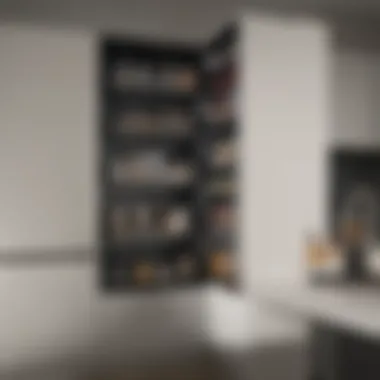

Galley Kitchen Design
The galley kitchen design is characterized by two parallel countertops. This layout is exceptional for small spaces. It maximizes efficiency by providing a clear path for movement. Most importantly, it can create an intuitive workflow for cooking. In a galley kitchen, one side can house the stove and oven while the opposite side can accommodate the sink and prep area.
Some benefits of this design include:
- Compactness: Everything is within reach, making it easy to navigate.
- Space-efficient: Uses minimal floor space while providing ample storage.
- Improved Functionality: The linear design allows for effective organization of cooking tools and ingredients.
However, a galley kitchen can feel cramped if not designed properly. Using lighter colors and adequate lighting can help to mitigate this feeling.
L-Shaped Kitchen Configuration
An L-shaped kitchen is another popular layout choice. This design utilizes two walls of the kitchen, creating an ‘L’ shape. One wall typically accommodates the cooking appliances, such as the stove and refrigerator.
One main advantage of an L-shaped configuration is its flexibility. Homeowners can create different zones for cooking, prepping, and dining. Additionally:
- Open Layout: This design can be integrated with the living space, fostering a more sociable atmosphere.
- Increased Counter Space: Two sides provide more area for meal prep and can be customized to include bar seating.
It is essential to keep traffic patterns in mind. Ensuring that pathways between the kitchen and other areas are clear will enhance usability and flow, particularly in smaller formats.
Island Options and Their Benefits
Including an island in a studio apartment kitchen can significantly improve its functionality. Islands serve multiple purposes: work space, storage, and even dining.
The benefits of kitchen islands include:
- Additional Counter Space: Cooking and meal prep become more convenient with extra surfaces.
- Storage Opportunities: Many islands can integrate drawers and shelves, offering room for pots, pans, and other essentials.
- Social Hub: An island can serve as a casual dining area, making it easier to entertain guests.
However, it's important to ensure there is sufficient room for movement around the island. A minimum of 36 inches should be left for walkways around it. This allows for comfortable access and prevents any overcrowding, maintaining a pleasant cooking environment.
Considering the layout of a kitchen in a studio apartment is crucial. It sets the tone for both functionality and aesthetics.
Selecting Appliances Wisely
Choosing the right appliances for a studio apartment kitchen is crucial. With limited space, every appliance must serve a practical purpose while complementing the overall design. Thoughtful selection of appliances can maximize functionality and efficiency. It is essential to consider several factors, including size, energy efficiency, and versatility. The right appliances can transform a compact kitchen into a productive space.
Space-Saving Appliances
Space-saving appliances are designed to fit seamlessly into smaller environments while providing essential functions. Compact refrigerators, for example, can save space without sacrificing storage capacity. Models such as a counter-depth refrigerator integrated under the countertop can make the kitchen feel more open, avoiding the bulky appearance of traditional units. Likewise, slim-line dishwashers available in 18-inch widths can maintain cleanliness without consuming excessive kitchen space.
In addition to refrigerators and dishwashers, consider using lean cooking appliances. An induction cooktop is often more compact than traditional stoves and heats faster, improving cooking speed and efficiency. Moreover, stackable or compact washers and dryers can be placed in tight areas, ensuring that your kitchen remains functional.
Multipurpose Kitchen Gadgets
In a studio kitchen, utilizing multipurpose gadgets is an effective strategy for maximizing functionality while minimizing clutter. For instance, a combination microwave and convection oven can serve multiple cooking needs, from reheating meals to baking. This allows for diverse cooking options without the need for separate gadgets.
Another versatile tool is a food processor. A single device can chop, blend, and knead, reducing the number of appliances in the kitchen. It is wise to also consider a pressure cooker, which can fulfill various cooking styles, from slow cooking to quick steaming, catering to different meal preparations with ease.
Using such multipurpose gadgets not only conserves space but also enhances the cooking experience. The less clutter your kitchen has, the easier it is to maintain an organized and efficient cooking environment.
"Smart appliance selection is key in compact spaces, where every element counts."
Maximizing Storage Solutions
In studio apartments, space is at a premium. Every square foot matters, and a well-organized kitchen can significantly enhance functionality. Maximizing storage solutions is crucial because it allows residents to have the necessary cooking tools and ingredients handy without cluttering the limited space. An effective storage system can transform how a small kitchen supports daily activities, making it not just a cooking area, but a multi-functional space for dining and social gatherings.
Vertical Storage Options
Vertical storage options are essential in studio kitchens. By utilizing the height of the walls, homeowners can create additional storage without sacrificing floor space. Tall shelving units or hanging racks provide easy access to pots, pans, and spices. This strategy is particularly effective in tight areas where horizontal expansion is impossible.
When designing vertical storage, consider:
- Open Shelving: It can showcase attractive dishes or serve as a practical spot for frequently used items.
- Hanging Pot Racks: These free up valuable cabinet space and can double as an aesthetic feature.
- Wall-Mounted Hooks: Installing hooks for utensils or mugs keeps them within reach while adding character to the kitchen.
Utilizing vertical storage not only maximizes space but also enhances the kitchen's overall decor. The elevation helps draw the eye upward, creating an illusion of a larger space.
Under-Counter and Overhead Cabinets
Under-counter and overhead cabinets are traditional solutions but remain vital in any studio kitchen design. These cabinets can store a variety of items, from dishes and cookware to food supplies. Below are key considerations:
- Depth and Height: Choose cabinets that do not overwhelm the room's proportions. Shallow cabinets can be ideal for limited spaces.
- Multi-Functional Designs: Select cabinets that feature pull-out shelves or hidden compartments. These features enhance accessibility and can help maintain a tidy appearance.
Overhead cabinets are particularly useful in keeping bulky appliances or food storage out of sight. However, it is important not to overcrowd these spaces. A well-organized cabinet can prevent clutter and improve overall kitchen efficiency.
Utilizing Nooks and Crannies
Nooks and crannies in a studio kitchen present unique opportunities for additional storage. Every small space can be utilized effectively to increase functionality. This involves creative thinking about how to enhance storage without adding clutter.
Consider incorporating:
- Corner Shelves: These can accommodate seldom-used items while maximizing otherwise wasted space.
- Pull-Out Drawers: They are great for deep cabinets and allow easy access to items in the back.
- Storage Baskets: Adding stylish baskets can organize pantry items or dish towels while keeping them visible and accessible.
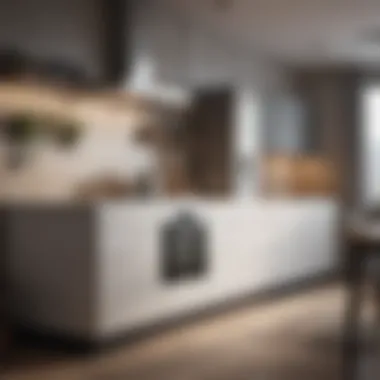
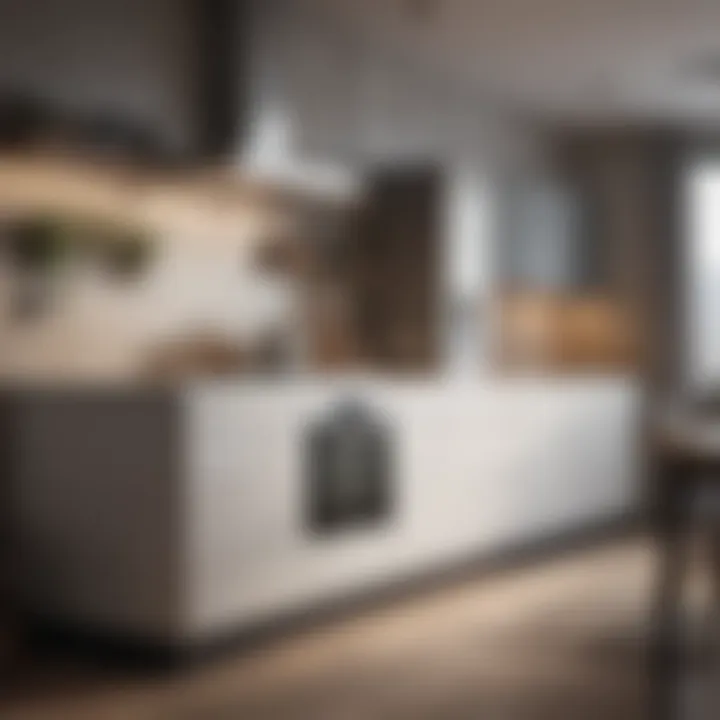
Incorporating these solutions encourages smart organization. It ensures that every area in the kitchen serves a purpose, maintaining a seamless environment for cooking and hosting.
In summary, maximizing storage solutions is vital in studio apartments. It allows for an organized kitchen that reflects personal style while ensuring functionality.
The right choices can transform a constrained space into a well-ordered culinary hub.
Designing for Aesthetics and Function
Creating a kitchen in a studio apartment demands a balance between aesthetics and functionality. The constraints of space can make it easy to prioritize one over the other, but they both play crucial roles. Aesthetic appeal contributes to a pleasant living environment, while functional design ensures the kitchen remains practical for everyday use. A well-designed kitchen should reflect personal style yet remain efficient and user-friendly.
Serious consideration of how a kitchen's aesthetics can complement its function is vital. Thoughtful design choices can elevate the ambiance and utility of the space. Colors, materials, and layouts should work in concert to create an environment that is both inviting and capable of handling daily tasks. This section covers various specific elements such as color palettes, lighting, and surface materials, all of which are fundamental in achieving a harmonious balance.
Choosing the Right Color Palette
The color palette sets the tone for the kitchen. In a studio apartment where space is limited, choosing light colors can create an illusion of openness. Shades of white, beige, or soft pastels reflect light and make the area feel larger. However, using an accent color can add character and avoid a sterile appearance. Shades of green or blue can instill calmness, while yellows may introduce warmth.
Here are a few tips when selecting colors:
- Light Colors: Use whites and light grays for walls and cabinetry.
- Accents: Incorporate a bolder hue for accessories like dishware or small appliances.
- Consistency: Ensure colors used in the kitchen harmonize with the rest of the living space.
Lighting Considerations
Lighting can transform any kitchen, small or large. In a studio apartment, proper lighting can enhance both aesthetics and functionality. Natural light is ideal, so maximizing windows or utilizing sheer curtains can benefit the ambiance. When natural light is limited, consider layered lighting, which includes ambient, task, and accent lighting.
- Ambient Lighting: Main light sources, like ceiling fixtures, should illuminate the whole space well.
- Task Lighting: Focused lights above countertops make food preparation easier and safer.
- Accent Lighting: Adding under-cabinet lights can add depth and highlight décor elements.
In summary, a well-illuminated kitchen does not merely function—it elevates the user experience.
Durable Materials for Surfaces
Tough surfaces are non-negotiable in busy kitchens. In studio apartments, where space is shared, frequent use can mean more wear and tear. Selecting durable materials for countertops, cabinetry, and floors will lead to a long-lasting kitchen that can withstand daily use.
- Countertops: Materials like quartz or granite are beautiful and robust, resisting scratches and stains.
- Cabinetry: Opt for high-quality plywood or hardwood that can better endure humidity and temperature shifts.
- Flooring: Vinyl or porcelain tiles can provide both resilience and style while being easier to clean.
Investing in quality materials may result in higher upfront costs, but the longevity and reduced maintenance will pay off in the long run.
Remember: Functionality should never be sacrificed for style. The kitchen should be easy to maintain while reflecting your unique taste.
Integrating Technology into Kitchen Design
Integrating technology into kitchen design is a crucial element for studio apartments. This integration significantly enhances the functionality and efficiency of compact spaces. With the ever-evolving landscape of smart home devices, homeowners can achieve a level of convenience and sophistication that was once relegated to larger, more spacious kitchens. The use of technology in kitchen design not only saves space but also optimizes the daily cooking and cleaning processes, catering well to the busy lifestyles typical of studio apartment residents.
Key benefits of incorporating technology include:
- Space optimization: Smart appliances often have compact designs, making them suitable for limited layouts.
- Energy efficiency: Many modern devices have settings that reduce energy consumption, which is vital for small apartments.
- Enhanced functionality: Technology allows for features like automated cooking and remote monitoring, adding convenience to daily tasks.
Considerations when integrating technology into kitchen design should include compatibility with other home devices, ease of use, and overall cost efficiency. These factors shape the final user experience and ensure that technology aids rather than complicates kitchen activities.
Smart Kitchen Solutions
Smart kitchen solutions have gained significant popularity, transforming how individuals engage with their cooking spaces. Many innovative appliances now integrate with smartphones or smart home systems. This connectivity allows users to control their kitchen environment remotely, providing flexibility and convenience.
Some examples include:
- Smart refrigerators that allow remote inventory tracking and management.
- Automated coffee makers that can be scheduled via apps.
- Smart ovens that can be preheated while en route home.
These solutions not only enhance convenience but also promote efficient food preparation. When selecting smart devices, focus on those that align with your cooking habits and preferences. Always consider how these devices will fit into your existing space and routine to maximize their benefits.
Managing Kitchen Inventory Online
Managing kitchen inventory online is increasingly practical for those living in studio apartments. This approach offers a streamlined way to keep track of groceries and supplies. Several apps and systems make it easy to maintain an organized kitchen without the need for large storage.
Benefits of online inventory management include:
- Reduced waste: Tracking items helps avoid over-purchasing and ensures you use what you have.
- Improved planning: Knowing what ingredients are available can help with meal planning and reduce last-minute grocery trips.
- Enhanced budgeting: By monitoring pantry supplies, it becomes easier to stay within a budget, a critical consideration for many homeowners.
Using cloud-based apps, one can access their inventory from anywhere, facilitating a flexible cooking routine. It is an effective way to ensure that a small kitchen remains functional and organized, ultimately enhancing the overall living experience in a studio apartment.
Sustainability in Kitchen Design
Sustainability in kitchen design is paramount, particularly for those living in studio apartments. As urban living spaces shrink, it is essential to make mindful choices that not only conserve space but also promote environmental responsibility. By integrating eco-friendly practices into kitchen design, homeowners can contribute to a healthier planet while enhancing the efficiency of their living spaces.
Choosing Eco-Friendly Materials
The selection of materials plays a crucial role in making a kitchen sustainable. Opting for eco-friendly materials can significantly reduce environmental impact. Here are some factors to consider:
- Bamboo and Cork: These materials are renewable and biodegradable. Bamboo is particularly strong and can withstand moisture, making it suitable for countertops and cabinetry.
- Recycled Materials: Consider using countertops made from recycled glass or paper. These options not only bring unique aesthetic values but also reduce waste.
- Low-VOC Paints: Volatile Organic Compounds (VOCs) are harmful gases emitted from various paints and finishes. Choosing low-VOC options contributes to better indoor air quality, which is important in tightly packed living environments.
Using sustainable materials does not mean compromising on style. Many eco-friendly options can be both attractive and functional.
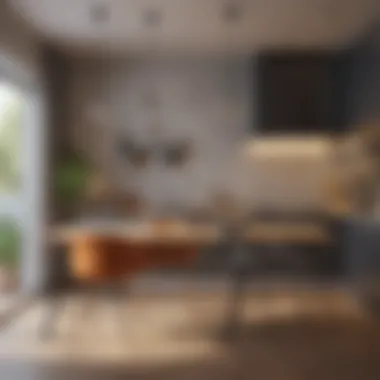
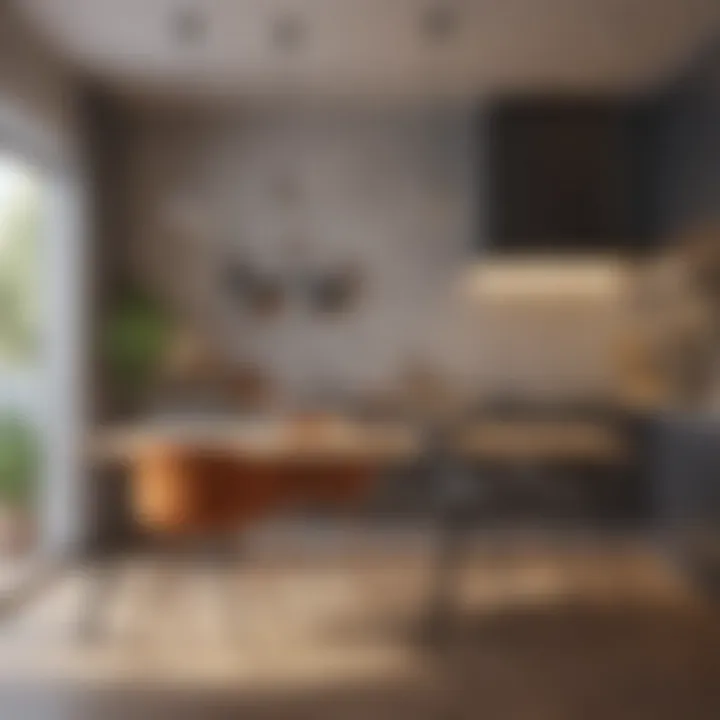
Energy Efficient Appliances
Appliances are one of the major energy consumers in a kitchen. Therefore, selecting energy-efficient models is an essential step in sustainable kitchen design. The benefits include:
- Lower Energy Consumption: Energy-efficient appliances such as refrigerators, stoves, and dishwashers can significantly reduce electricity bills.
- Long-Term Savings: While the initial cost might be higher, the investment pays off over time through reduced utility bills.
- Environmental Impact: Less energy use translates to lower greenhouse gas emissions, which is crucial for combating climate change.
Some specific appliances to consider include:
- Energy Star Rated Refrigerators: These models meet strict energy efficiency guidelines set by the U.S. Environmental Protection Agency.
- Induction Cooktops: These heat food faster and use less energy compared to traditional gas or electric ranges.
- High-Efficiency Dishwashers: These machines use less water and energy per load, making them a sustainable choice for smaller kitchens.
By thoughtfully considering materials and appliance choices, homeowners can create a functional kitchen that prioritizes sustainability without sacrificing style or usability.
Maintaining a Functional Kitchen
To achieve an efficient kitchen in a studio apartment, ongoing maintenance is crucial. A well-maintained kitchen extends the lifespan of appliances, optimizes space, and keeps the area looking stylish and inviting. This section outlines regular cleaning practices, upkeep tips, and seasonal strategies that can simplify maintenance while enhancing kitchen functionality.
Regular Cleaning and Upkeep
Routine cleaning is not just about aesthetics; it plays a vital role in the functionality of your kitchen. Regular maintenance helps prevent dirt buildup and ensures that appliances operate efficiently. Establish a cleaning schedule to cover key areas of your kitchen:
- Countertops: Wipe down surfaces daily to remove crumbs and spills. Use a suitable cleaner for your surface material, whether it's quartz, granite, or laminate.
- Stovetop and Oven: After cooking, clean the stove to prevent grease buildup and potential fire hazards. Deep clean the oven every few months to avoid unwanted smells.
- Refrigerator: Regularly check the fridge for expired food and spills. A clean fridge not only smells better but also saves energy.
- Floors: Sweep or vacuum the floor daily and mop weekly to keep the kitchen area spotless and sanitary.
An effective strategy is to make cleaning a part of your cooking routine. For example, clean dishes as you cook to reduce clutter. Additionally, consider using storage solutions that can be easily moved or cleaned around to minimize obstructions.
Seasonal Maintenance Tips
In addition to regular cleaning, seasonal maintenance helps identify larger issues before they become significant problems. Develop a habit of conducting thorough checks every season. Here are some tips to consider:
- Deep Cleaning: Every spring or fall, dedicate a day to deep cleaning your kitchen. Remove all items from cabinets and shelves, wash them thoroughly, and reorganize.
- Check for Wear and Tear: Inspect appliances for any signs of wear. Look for rust or unusual noises, especially in dishwashers and refrigerators that may need servicing.
- Pest Control: Seasonal changes can bring pests into your kitchen. Ensure all food is sealed and check for points of entry. Regularly inspect your pantry and consider strategies for pest prevention.
- Update Kitchen Inventory: Keep an updated list of kitchen supplies, and replace any items that are used frequently. This helps avoid overstocking and keeps essential items handy.
"A well-maintained kitchen not only enhances functionality but also creates a welcoming atmosphere, crucial for entertaining guests or enjoying quiet dinners at home."
Incorporating Personal Style
In studio apartments, where space is limited, integrating personal style into the kitchen design becomes a critical aspect of creating an inviting and functional atmosphere. Personal style reflects individuality and transforms a generic kitchen into a unique space that resonates with the owner’s taste. It is essential to consider the balance between aesthetics and functionality when designing this area.
One of the primary benefits of incorporating personal style is the boost in one’s mood and enjoyment while cooking or entertaining. A kitchen adorned with elements representing the owner's personality can elevate everyday tasks into pleasurable experiences. Additionally, personalized spaces often improve overall satisfaction with one’s living environment, making it feel more like home.
Moreover, the selection of colors, textures, and accessories can significantly influence the aesthetic appeal of a studio kitchen. Homeowners should pay attention to how these elements interact with the overall design theme of the apartment.
When selecting design elements, consider how they align with cooking habits and lifestyle needs. For instance, if an individual enjoys hosting, incorporating stylish yet practical accessories can enhance the experience when friends and family gather.
It is also vital to keep in mind that personalization should not hinder the kitchen’s functionality. Therefore, thoughtful choices are needed to achieve that perfect balance.
Display and écor Options
Display and décor options play a crucial role in personalizing a studio kitchen. The choices made can affect both visual appeal and the practicality of the space. Here are key considerations to keep in mind when selecting these options:
- Open Shelving: Incorporating open shelves allows one to display attractive dishes, glassware, or cookbooks. It is not just a decorative element but also makes essential items readily accessible.
- Wall Art and Prints: Adding wall art or personal photographs can infuse character into the kitchen. It brings warmth and represents the homeowner's taste.
- Plants and Herbs: Integrating plants into the kitchen serves a dual purpose. They not only beautify the space but also offer fresh herbs for culinary endeavors, enriching the cooking experience.
When choosing display items, opt for those that reflect personal history or preferences. Each selected item adds more than aesthetic value; it tells a part of one’s story.
Personalized Kitchen Accessories
Personalized kitchen accessories enhance the functional aspect of the kitchen while showcasing individual style. These accessories can range from cookware to décor items. Here are features to consider in this context:
- Customized Utensils: Items such as engraved cutting boards or personalized knife sets can be both functional and a conversation starter.
- Unique Cookware: Personalized cookware in distinctive colors or designs can brighten up the kitchen space, making cooking more enjoyable.
- Themed Towels and Aprons: These items introduce playful elements while serving practical purposes in the kitchen. Choosing designs or colors that resonate with personal interests can strengthen the kitchen's character.
When selecting accessories, prioritize versatility and quality. Each piece should serve a purpose while integrating seamlessly into the kitchen's design.
The End
A functional kitchen is pivotal in maximizing the potential of any studio apartment. In this article, we provided actionable insights into optimizing small kitchen spaces. By analyzing the layouts, we found that a well-thought-out design can greatly improve not just usability, but also aesthetic appeal.
Highlighting key elements like:
- Appliance selection: Choosing appliances that fit your space without sacrificing functionality is essential. Compact or multipurpose devices can make a significant difference.
- Storage solutions: Effective use of vertical space and creative storage options can help minimize clutter, which is common in studio settings.
- Overall design choices: Integrating architectural features with color palettes can result in an inviting environment.
The importance of these considerations cannot be overstated. They directly affect how one navigates daily tasks in the kitchen, influencing everything from meal preparation to entertaining guests.
"A well-conceived kitchen can transform a tiny space into a harmonious blend of function and style."
These insights serve as tools for homeowners and design enthusiasts aiming to enhance their kitchen experience. In the ever-evolving landscape of studio living, awareness of future trends will also support the longevity and relevance of your design choices.
Recap of Key Insights
In summary, effective kitchen design for studio apartments centers around:
- Understanding one’s cooking habits to inform design.
- Opting for layouts like L-shaped or galley configurations that maximize space.
- Selecting appliances wisely ensures both efficiency and space conservation.
- Storage enhancements through vertical storage and other creative methods reduces clutter.
- Maintaining a balance between functionality and aesthetic appeal fosters an enjoyable cooking environment.
- Evaluating personal style can enhance the kitchen's visual appeal without compromising utility.
Future Trends in Studio Kitchen Design
Looking forward, advancements in design technology and preferences in urban living will influence studio kitchens. Here are notable trends:
- Smart appliances: Integration of IoT technology enhances convenience, allowing users to manage kitchen tasks remotely.
- Sustainable materials: As eco-consciousness grows, more homeowners will gravitate towards eco-friendly materials for both appliances and surfaces.
- Multifunctional areas: Future kitchens will continue to adapt by becoming more versatile, serving multiple purposes beyond cooking, like working or socializing.
- Minimalist design: Simplified designs with clean lines will gain popularity, focusing on decluttering while making a stylish impact.
These trends reflect an increasing emphasis on versatile living solutions that meet the demands of contemporary lifestyles. Therefore, keeping abreast of these changes will be crucial for anyone involved in studio apartment design.















